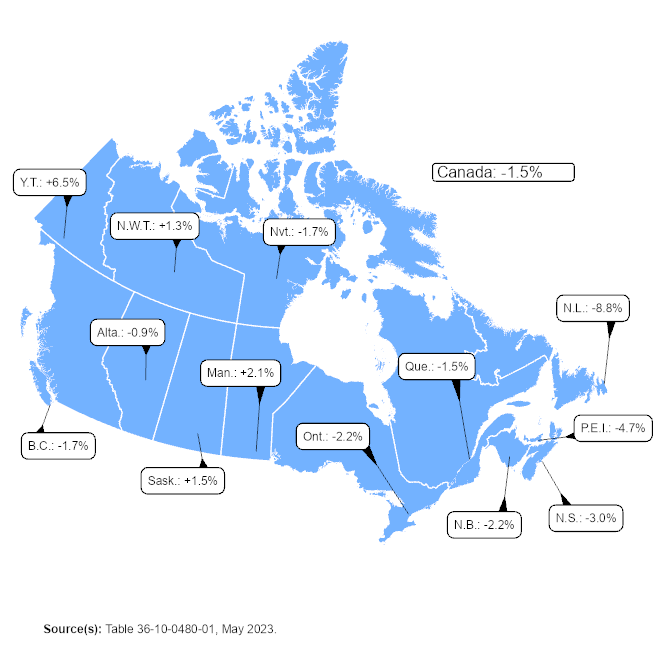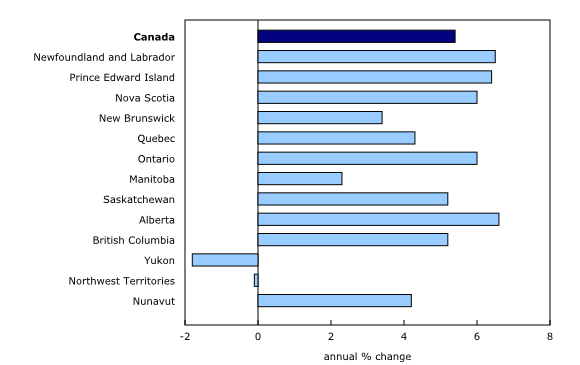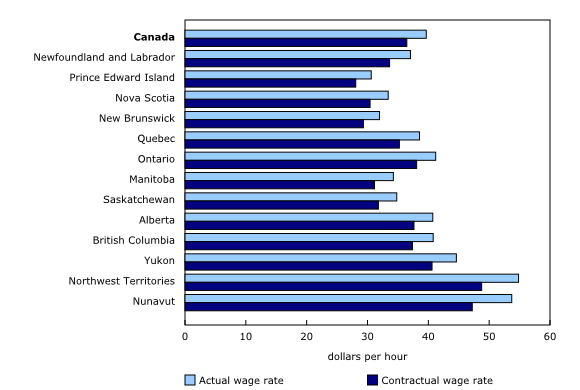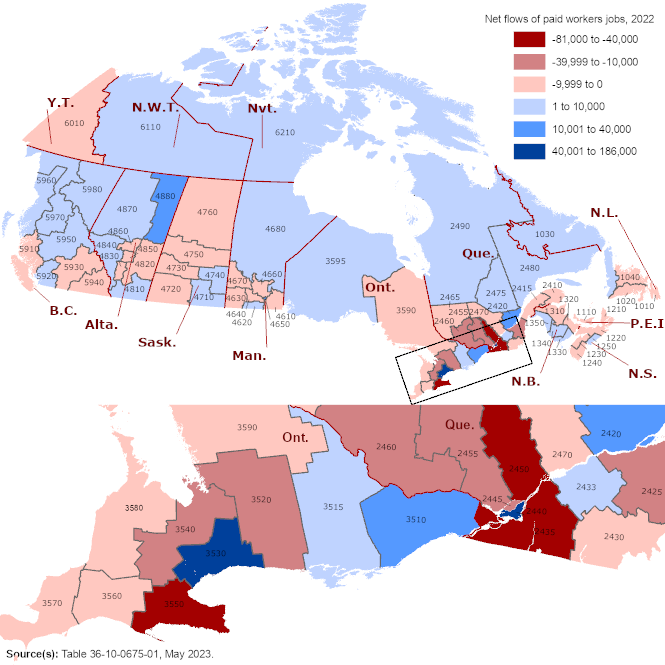Hours worked and labour productivity in the provinces and territories (preliminary), 2022
Released: 2023-05-19
$57.60 per hour
2022
-1.5% 
(annual change)
$80.00 per hour
2022
-8.8% 
(annual change)
$38.80 per hour
2022
-4.7% 
(annual change)
$41.50 per hour
2022
-3.0% 
(annual change)
$44.60 per hour
2022
-2.2% 
(annual change)
$51.70 per hour
2022
-1.5% 
(annual change)
$54.00 per hour
2022
-2.2% 
(annual change)
$52.80 per hour
2022
2.1% 
(annual change)
$85.40 per hour
2022
1.5% 
(annual change)
$79.90 per hour
2022
-0.9% 
(annual change)
$52.50 per hour
2022
-1.7% 
(annual change)
$82.20 per hour
2022
6.5% 
(annual change)
$110.90 per hour
2022
1.3% 
(annual change)
$113.10 per hour
2022
-1.7% 
(annual change)
In most provinces, the decline in productivity continues, but to a lesser extent than in 2021
In 2022, business productivity declined in every province except Manitoba and Saskatchewan. However, for most provinces, the decline in productivity was much smaller than in 2021. In the territories, productivity decreased only in Nunavut. At the national level, productivity decreased 1.5%, after a historic decline (-5.8%) in 2021 and record growth (+8.6%) in 2020 resulting from the COVID-19 pandemic.
Overall, business productivity in 2022 exceeded 2019 pre-pandemic levels in nine provinces and territories.
For a second consecutive year, Newfoundland and Labrador (-8.8% in 2022) recorded the largest decline in productivity of all the provinces, due to a decrease in oil and gas extraction in 2022 as well as 2021, resulting mainly from a reduction in offshore production. On the other hand, Manitoba (+2.1%) and Saskatchewan (+1.5%) were the only provinces to see their productivity return to growth in 2022, following large declines in 2021. The return to productivity growth in these two provinces was mainly due to significantly improved conditions for crop production in 2022, after being hit hard by a drought the previous year.
Hours worked continue to increase in all provinces, but at a much slower pace than in 2021
Real gross domestic product (GDP) in the business sector increased in all provinces and territories in 2022, except for Newfoundland and Labrador, where it declined by 2.8%. Meanwhile, hours worked in the business sector increased in all provinces, although that growth was slower than in 2021 for all provinces except Saskatchewan. In the territories, only Nunavut (+4.2%) experienced an increase in hours worked.
Nationally, growth in hours worked slowed to 5.4% in 2022, following a strong rebound (+11.5%) the previous year.
In all provinces and territories, hourly compensation increases at a much faster pace in 2022 than in 2021
In 2022, average compensation per hour worked in the business sector increased in all provinces and territories, with growth rates ranging from 2.9% in Alberta to 9.3% in Yukon. Overall, all provinces and territories posted higher growth than in 2021. Nationally, hourly compensation increased by 5.0% in 2022, compared with a slight decline of 0.8% the previous year.
Average hourly wage for full-time paid workers varies by province and territory
In 2022, the actual wage rate—that is, wages and salaries per hour worked—for full-time paid workers in the total economy varied across the provinces and territories. The wage rate ranged, on average, from $30.61 per hour in Prince Edward Island to $54.83 per hour in the Northwest Territories. Nationally, the average wage rate in the total economy was $39.66 per hour in 2022.
On the other hand, the contractual wage rate—that is, wages and salaries per hour paid—is lower than the actual wage rate. This is because hours paid differ from hours worked due to paid leave and unpaid overtime for paid workers.
In 2022, the wage gap between the actual and contractual rate persisted. The highest gap was observed in Nunavut, followed by the Northwest Territories, and the lowest was seen in Prince Edward Island, followed by New Brunswick.
In 2022, the inter-regional movements of paid workers in Canada are similar to those of the previous year
In general, the movements of workers between economic regions result in either a positive net flow (i.e., a net inflow of workers) when the region receives more workers from other regions than it provides to them, or a negative net flow in the opposite situation (i.e., a net outflow of workers).
As was the case in 2021, the top net suppliers or recipients of paid workers (10,000 workers or more) in 2022 were concentrated in eight economic regions in southern Quebec, five regions in southern Ontario, the Wood Buffalo–Cold Lake region in Alberta as well as the Winnipeg region in Manitoba.
Note to readers
This release incorporates an update to 2022 data on provincial and territorial labour productivity and related measures. No revisions have been made to data for previous years.
These revisions are consistent with those incorporated in the release on provincial and territorial gross domestic product (GDP) by industry for 2022 (released on May 1, 2023) and the release on national GDP by industry (released on April 28, 2023).
Preliminary estimates also take into account revised data of the Survey of Employment, Payrolls and Hours for 2022 (released on March 30, 2023). They also incorporate revised data of the Labour Force Survey (released on January 30, 2023).
As part of an effort to increase the relevance of provincial and territorial data, we would like to remind users that two new tables—which contain an experimental data set of labour statistics by economic region and work schedule—were released for the first time on May 20, 2022. Specifically, these new tables represent an expansion of two other existing data tables (36-10-0489-01 and 36-10-0480-01). The first new table (36-10-0675-01) contains labour statistics by economic region and job category, while the second new table (36-10-0676-01) contains labour statistics by work schedule (full-time or part-time).
For more detailed information on the economic region codes, see "Variant of Standard Geographical Classification (SGC) 2021 for Economic Regions."
Productivity measures
The term productivity in this release refers to labour productivity. For the purposes of this analysis, as in the national labour productivity releases, productivity and related measures cover the business sector only. However, average hourly wages for full-time and part-time paid workers and the net flows of jobs by economic region in this analysis are focused on the total economy.
Labour productivity is a measure of real gross domestic product per hour worked. Productivity gains occur when the production of goods and services grows faster than the volume of work dedicated to their production.
Economic performance, as measured by labour productivity, must be interpreted carefully, as these data reflect changes in other inputs, in particular capital, in addition to the efficiency growth of production processes. As well, growth in labour productivity is often influenced by the degree of diversity in the industrial structure. As a result, labour productivity tends to be more volatile in the smaller provinces.
It is important to note that real output (used to measure productivity) is based on the value added measured at basic prices, not market prices, which is consistent with the detailed framework by industry.
As well, the real estate, rental and leasing industry, part of the service-producing business sector, excludes the imputed rent for owner-occupied dwellings as there are no data on the number of hours that homeowners spend on dwelling maintenance services.
Next release
Revised estimates of hours worked and labour productivity in the provinces and territories for 2020 to 2022 will be published on February 9, 2024, with the incorporation of the new benchmark data from the provincial and territorial supply and use tables for reference year 2020.
Products
The Economic accounts statistics portal, accessible from the Subjects module of our website, features an up-to-date portrait of national and provincial economies and their structure.
The Latest Developments in the Canadian Economic Accounts (13-605-X) is available.
The User Guide: Canadian System of Macroeconomic Accounts (13-606-G) is also available.
The Methodological Guide: Canadian System of Macroeconomic Accounts (13-607-X) is also available.
Contact information
For more information, or to enquire about the concepts, methods or data quality of this release, contact us (toll-free 1-800-263-1136; 514-283-8300; infostats@statcan.gc.ca) or Media Relations (statcan.mediahotline-ligneinfomedias.statcan@statcan.gc.ca).
- Date modified:




